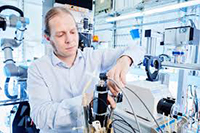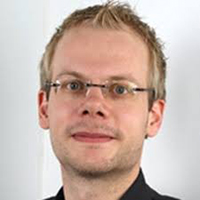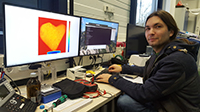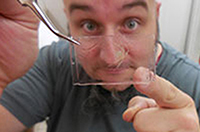 Viktor A. Baranov. Biology II, Ludwig-Maximilians-Universität München, Planegg, Bayern, Germany. Correspondence author. baranow@biologie.uni-muenchen.de
Viktor A. Baranov. Biology II, Ludwig-Maximilians-Universität München, Planegg, Bayern, Germany. Correspondence author. baranow@biologie.uni-muenchen.de
Viktor Baranov studied biology (BSc) and zoology & animal ecology (MSc, honors) at the V.N. Karazin Kharkiv National University (Ukraine). After completion of the Master degree in 2011, he worked for two years as a adjunct at the department of zoology of his alma mater, teaching medical zoology and parasitology. Between 2011 and 2013 he visited number of the international labs, including entomological laboratory of the Bergen University Museum (Norway), Gdansk laboratory of the amber Palaeobiology(Poland) and Zoological Institute in St. Petersburg (Russia). In 2014 Viktor Baranov has won Marie Curie early career fellowship, which allowed him to pursue phd in the ecology and biogeochemical impact of the aquatic insects on the carbon and oxygen cycles in lakes. After receiving his phd in Environmental and Earth science (2017) from Humboldt University of Berlin, he proceeded for a 1.5 year postdoc in the department of River Ecology and Conservation of Senckenberg Museum (Gelnhausen), working on long term trends in aquatic insect communities. Since October 2018 he works in the Joachim Haug’s research group (LMU Munich), dealing with evolutionary biology and ecology of the Holometabolan insects larvae. Life long interest, and encompassing framework of the Viktor Baranov’s studies is biology and geological history of aquatic Diptera, predominantly Chironomidae.

 Michael S. Engel. Natural Sciences and Mathematics - Ecology & Evolutionary Biology, KU Biodiversity Institute, Kansas, USA. msengel@ku.edu
Michael S. Engel. Natural Sciences and Mathematics - Ecology & Evolutionary Biology, KU Biodiversity Institute, Kansas, USA. msengel@ku.edu
Michael S. Engel studied chemistry (BA) and physiology and cell biology (BSc) at the University of Kansas before completing a doctorate in Entomology at Cornell University (1998). Following Cornell, he was a Research Scientist in the Department of Entomology (later Division of Invertebrate Zoology) at the American Museum of Natural History . From there he became a curator and professor at the University of Kansas Natural History Museum, where today he is University Distinguished Professor and Senior Curator, as well as a Research Associate of the American Museum of Natural History. He studies the diversity of living and fossil insects, with his work bringing him to about 50 countries in order to collect modern species as well as ancient fossils.

 Jörg Hammel. Institute of Materials Research, Helmholtz-Zentrum Geesthacht, Geesthacht, Germany. joerg.hammel@hzg.de
Jörg Hammel. Institute of Materials Research, Helmholtz-Zentrum Geesthacht, Geesthacht, Germany. joerg.hammel@hzg.de
Jörg U. Hammel is working as Scientist in Helmholtz-Zentrum Geesthacht Zentrum für Material- und Küstenforschung. He worked as Postdoctoral Scientist in Friedrich-Schiller-Universität Jena and University of Amsterdam. He have received his Diploma in Technical biology from the University of Stuttgart and his PhD in Zoology from Friedrich-Schiller-Universität Jena.

 Marie K. Hörnig. University of Greifswald, Zoological Institute and Museum,Cytology and Evolutionary Biology, Greifswald, Germany. marie.hoernig@palaeo-evo-devo.info
Marie K. Hörnig. University of Greifswald, Zoological Institute and Museum,Cytology and Evolutionary Biology, Greifswald, Germany. marie.hoernig@palaeo-evo-devo.info
Marie K. Hörnig is a postdoctoral researcher in the work group of Steffen Harzsch at the University of Greifswald, but is also associated with the Palaeo-Evo-Devo group of Carolin and Joachim T. Haug at the LMU Munich. During her Diploma and PhD thesis in Greifswald, she worked on the evolution of ontogenesis and the deep-time aspects of social and brood care behaviour of Dictyoptera, as well as the origin of the different morphotypes within this insect group. In the context of her Ph.D. studies she broadens this approach and investigates the evolution of reproductive strategies of fossil insects in general. A further focus of her are imaging methods, especially for amber. These methods comprises, e.g. light microscopy and composite macrophotography under polarised light, stereo photography, micro-computed tomography, and virtual surface reconstructions.

 Thomas van de Kamp. Institute for Photon Science and Synchrotron Radiation (IPS), Karlsruhe Institute of Technology (KIT), Hermann-von-Helmholtz-Platz 1, 76344 Eggenstein-Leopoldshafen, Germany and Laboratory for Applications of Synchrotron Radiation (LAS), Karlsruhe Institute of Technology (KIT), Kaiserstr. 1, 76131 Karlsruhe, Germany. thomas.vandekamp@kit.edu
Thomas van de Kamp. Institute for Photon Science and Synchrotron Radiation (IPS), Karlsruhe Institute of Technology (KIT), Hermann-von-Helmholtz-Platz 1, 76344 Eggenstein-Leopoldshafen, Germany and Laboratory for Applications of Synchrotron Radiation (LAS), Karlsruhe Institute of Technology (KIT), Kaiserstr. 1, 76131 Karlsruhe, Germany. thomas.vandekamp@kit.edu
Current positions: Project Leader „In-house research: Life Sciences“, Head of the IPS BioLab
Previous positions:; Research assistant at IPS; Scientific Trainee at State Museum of Natural History Karlsruhe; PhD Student at Heinrich Heine University Düsseldorf
Field of research: Functional morphology and evolutionary biology of insects: Digital imaging of biological and paleontological specimens; Biomimetics.
My research interests include: - Functional morphology of insects - X-ray imaging of biological and paleontological specimens - Biomimetics

 Marcus Zuber. Institute for Photon Science and Synchrotron Radiation (IPS), Karlsruhe Institute of Technology (KIT), Hermann-von-Helmholtz-Platz 1, 76344 Eggenstein-Leopoldshafen, Germany and Laboratory for Applications of Synchrotron Radiation (LAS), Karlsruhe Institute of Technology (KIT), Kaiserstr. 1, 76131 Karlsruhe, Germany. marcus.zuber@kit.edu
Marcus Zuber. Institute for Photon Science and Synchrotron Radiation (IPS), Karlsruhe Institute of Technology (KIT), Hermann-von-Helmholtz-Platz 1, 76344 Eggenstein-Leopoldshafen, Germany and Laboratory for Applications of Synchrotron Radiation (LAS), Karlsruhe Institute of Technology (KIT), Kaiserstr. 1, 76131 Karlsruhe, Germany. marcus.zuber@kit.edu
Current positions: Head of CL/CT-Laboratory setup, PhD Student
Field of research: Spectroscopic & cone beam CT/CL, Photon counting detectors, phase contrast imaging

 Joachim T. Haug. Biology II, Ludwig-Maximilians-Universität München, Planegg, Bayern, Germany and Geobio-Center, Ludwig-Maximilians-Universität München, München, Bayern, Germany. jhaug@biologie.uni-muenchen.de
Joachim T. Haug. Biology II, Ludwig-Maximilians-Universität München, Planegg, Bayern, Germany and Geobio-Center, Ludwig-Maximilians-Universität München, München, Bayern, Germany. jhaug@biologie.uni-muenchen.de
Joachim T. Haug studied animal ecology (major), sociobiology and palaeontology (minors) at the Julius-Maximilians-Universität Würzburg. After the receipt of the Diplom in 2005, he moved to the work group Biosystematic Documentation at the University of Ulm for his PhD thesis. There he worked on the early crustaceans from the Cambrian 'Orsten', which are preserved three-dimensionally and with minute details. To make the entire morphology clearly visible, Joachim produced computer-based 3D models for each developmental stage of a species, resulting in a 4D model of the species. With 4D models reconstructed for the different species, differences in the developmental pattern between the species became visible. These changes in the developmental timing, so-called heterochronic events must have occurred several times during early crustacean evolution. Due to these findings, Joachim got interested in studying such evolutionary changes of development also in fossils from other deposits and focussed on Palaeo-Evo-Devo (see also http://www.palaeo-evo-devo.info). After his defense in 2009 and two further years as postdoctoral researcher in Ulm, he received two Feodor Lynen research fellowships from the Alexander von Humboldt-Foundation, with which he was doing research at Yale University and at the Ernst-Moritz-Arndt-Universität Greifswald. Besides 3D modelling, Joachim is also interested in different methods of imaging (documentation and presentation). In September 2013, he relocated to the Ludwig-Maximilians-Universität in Munich. In April 2018 Joachim became a Lichtenberg professor at the Ludwig-Maximilians-Universität München (LMU Munich) funded by the Volkswagen Foundation.

